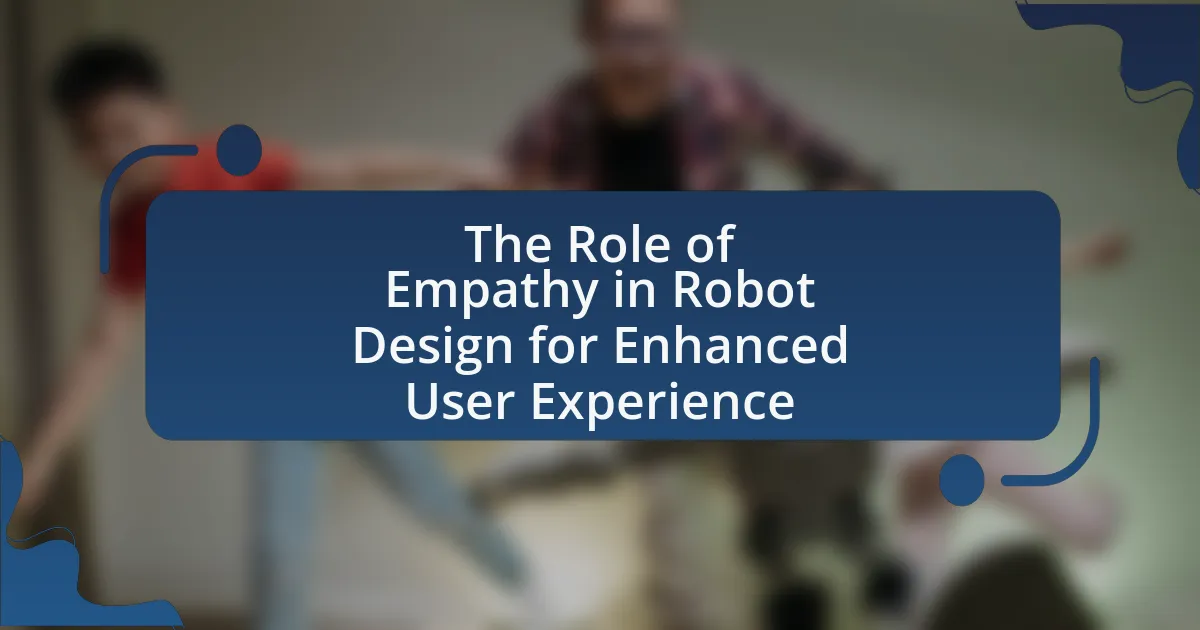User testing is a critical component in the development of effective robot interfaces, providing essential insights into user interactions and preferences. This article explores the significant role of user testing in identifying usability issues, enhancing user satisfaction, and refining interface design through real-world feedback. It discusses various methodologies employed in user testing, such as usability testing, A/B testing, and heuristic evaluation, and highlights the importance of integrating user feedback throughout the development process. Additionally, the article addresses the challenges developers face in implementing user testing and offers best practices for conducting effective evaluations to ensure that robot interfaces meet user needs and expectations.

What is the Role of User Testing in Developing Effective Robot Interfaces?
User testing plays a crucial role in developing effective robot interfaces by providing insights into user interactions and preferences. This process allows developers to identify usability issues, assess user satisfaction, and refine interface design based on real-world feedback. For instance, studies have shown that user testing can lead to a 50% reduction in usability problems when iteratively applied during the design phase. By observing users as they interact with robots, developers can gather data on task completion rates, error frequencies, and user engagement levels, which are essential for creating intuitive and efficient interfaces.
How does user testing contribute to the design of robot interfaces?
User testing significantly enhances the design of robot interfaces by providing direct feedback from actual users, which informs design decisions. This feedback helps identify usability issues, preferences, and pain points that designers may not anticipate, leading to more intuitive and user-friendly interfaces. For instance, studies have shown that iterative user testing can reduce errors in task completion by up to 30%, as it allows designers to refine functionalities based on real user interactions. By incorporating user insights, developers can create interfaces that better meet the needs and expectations of users, ultimately improving the overall effectiveness and satisfaction with the robot’s performance.
What methodologies are commonly used in user testing for robot interfaces?
Common methodologies used in user testing for robot interfaces include usability testing, A/B testing, and heuristic evaluation. Usability testing involves observing users as they interact with the robot interface to identify pain points and areas for improvement. A/B testing compares two versions of an interface to determine which performs better based on user engagement and satisfaction metrics. Heuristic evaluation employs a set of usability principles to assess the interface’s design and functionality, allowing experts to identify potential usability issues. These methodologies are validated by their widespread application in both academic research and industry practices, demonstrating their effectiveness in enhancing user experience with robot interfaces.
How do user feedback and testing influence interface design decisions?
User feedback and testing significantly influence interface design decisions by providing direct insights into user experiences and preferences. This feedback allows designers to identify usability issues, prioritize features, and make informed adjustments to enhance user satisfaction. For instance, studies have shown that iterative testing can lead to a 50% reduction in user errors and a 30% increase in task completion rates, demonstrating the tangible benefits of incorporating user input into the design process. By analyzing user interactions and preferences, designers can create more intuitive and effective interfaces that align with user needs and expectations.
Why is user testing essential for effective robot interfaces?
User testing is essential for effective robot interfaces because it ensures that the design meets user needs and expectations. By observing real users interacting with the robot, developers can identify usability issues, misunderstandings, and areas for improvement. Research indicates that user-centered design, which incorporates user feedback through testing, leads to interfaces that are more intuitive and easier to use. For instance, a study by Nielsen Norman Group found that usability testing can uncover 85% of usability problems, significantly enhancing user satisfaction and overall performance of robotic systems.
What are the potential risks of neglecting user testing in robot interface development?
Neglecting user testing in robot interface development can lead to significant usability issues, resulting in user frustration and decreased efficiency. Without user testing, developers may overlook critical design flaws that hinder interaction, leading to a product that does not meet user needs or expectations. For instance, a study by Nielsen Norman Group highlights that usability testing can identify issues that affect user satisfaction and task completion rates, which are often missed during the design phase. Additionally, the absence of user feedback can result in increased training time and errors during operation, ultimately impacting the overall effectiveness of the robot interface.
How does user testing enhance user experience and satisfaction?
User testing enhances user experience and satisfaction by identifying usability issues and gathering direct feedback from users. This process allows developers to understand user needs and preferences, leading to more intuitive and user-friendly interfaces. Research shows that products designed with user input have a 50% higher success rate in meeting user expectations, as evidenced by a study conducted by Nielsen Norman Group, which highlights that user-centered design significantly improves overall satisfaction and engagement.

What are the key components of user testing in robot interface development?
The key components of user testing in robot interface development include participant selection, task design, data collection, and analysis. Participant selection ensures that a diverse group of users, representative of the target audience, is involved in the testing process, which enhances the validity of the results. Task design focuses on creating realistic scenarios that users will encounter while interacting with the robot, allowing for the assessment of usability and functionality. Data collection involves gathering quantitative and qualitative feedback through methods such as surveys, interviews, and observation, which provides insights into user experiences and challenges. Finally, analysis of the collected data identifies patterns and areas for improvement, guiding the iterative design process to enhance the robot interface. These components collectively contribute to developing effective and user-friendly robot interfaces.
What types of user testing are most effective for robot interfaces?
Usability testing, heuristic evaluation, and A/B testing are the most effective types of user testing for robot interfaces. Usability testing involves observing real users as they interact with the robot, providing insights into user behavior and interface challenges. Heuristic evaluation allows experts to assess the interface against established usability principles, identifying potential issues before user testing. A/B testing compares two versions of an interface to determine which performs better based on user engagement and task completion rates. These methods collectively enhance the design and functionality of robot interfaces, ensuring they meet user needs effectively.
How do usability tests differ from A/B testing in this context?
Usability tests focus on evaluating how real users interact with a product to identify usability issues, while A/B testing compares two or more variations of a product to determine which performs better based on specific metrics. In the context of developing effective robot interfaces, usability tests provide qualitative insights into user behavior and preferences, helping to refine interface design, whereas A/B testing quantitatively measures user engagement or task completion rates to optimize specific features. This distinction is crucial, as usability tests inform design improvements through user feedback, while A/B testing validates design choices through statistical analysis of user interactions.
What role does observational testing play in understanding user interactions?
Observational testing plays a crucial role in understanding user interactions by providing direct insights into how users engage with a system in real-time. This method allows researchers to observe behaviors, identify pain points, and gather qualitative data that quantitative methods may overlook. For instance, studies have shown that observational testing can reveal discrepancies between user expectations and actual interactions, leading to more informed design decisions. By capturing user actions and reactions in their natural environment, observational testing enhances the understanding of user needs and preferences, ultimately contributing to the development of more effective robot interfaces.
How can user testing be integrated into the development process?
User testing can be integrated into the development process by incorporating it at multiple stages, including planning, design, and post-launch evaluation. During the planning phase, developers can define user personas and scenarios to guide the design process. In the design phase, iterative testing with prototypes allows for real-time feedback, enabling adjustments based on user interactions. Finally, post-launch evaluations through usability testing can identify areas for improvement, ensuring the interface meets user needs effectively. Research indicates that integrating user testing throughout the development cycle leads to a 50% reduction in usability issues, as highlighted in the study “The Impact of User Testing on Software Development” by Nielsen Norman Group.
What are the best practices for conducting user testing during different development phases?
The best practices for conducting user testing during different development phases include early involvement of users, iterative testing, and context-specific evaluations. Early involvement of users ensures that their needs and expectations are identified from the outset, which is crucial for effective robot interface design. Iterative testing allows for continuous feedback and refinement, enhancing usability and functionality as the development progresses. Context-specific evaluations focus on testing in environments that closely mimic real-world usage, ensuring that the robot interfaces perform effectively under actual conditions. Research indicates that incorporating user feedback at each phase can lead to a 30% increase in user satisfaction and a 25% reduction in usability issues, demonstrating the importance of these practices in developing effective robot interfaces.
How can iterative testing improve the final product?
Iterative testing improves the final product by allowing for continuous refinement based on user feedback. This process involves repeated cycles of testing, evaluation, and modification, which helps identify usability issues and areas for enhancement early in development. Research indicates that products developed through iterative testing often achieve higher user satisfaction rates, as they are more aligned with user needs and preferences. For instance, a study by Nielsen Norman Group found that usability testing can reduce the number of usability issues by up to 80% when conducted iteratively. This evidence supports the effectiveness of iterative testing in creating more effective and user-friendly robot interfaces.

What challenges are associated with user testing for robot interfaces?
User testing for robot interfaces faces several challenges, primarily due to the complexity of human-robot interaction. One significant challenge is the variability in user behavior and preferences, which can lead to inconsistent results during testing. Additionally, the technical limitations of robots, such as sensor accuracy and response time, can hinder effective user interaction, making it difficult to assess usability accurately. Furthermore, the need for specialized environments to simulate real-world scenarios can complicate the testing process, often requiring extensive resources and time. These factors collectively contribute to the difficulty in obtaining reliable and generalizable data from user testing for robot interfaces.
What common obstacles do developers face when implementing user testing?
Developers commonly face obstacles such as limited access to representative users, time constraints, and budget limitations when implementing user testing. Limited access to users can hinder the ability to gather diverse feedback, which is crucial for understanding various user needs and behaviors. Time constraints often lead to rushed testing processes, resulting in inadequate data collection and analysis. Budget limitations can restrict the resources available for comprehensive testing, including tools and participant incentives, ultimately affecting the quality of insights gained. These challenges can significantly impact the effectiveness of user testing in developing robot interfaces.
How can developers overcome biases in user testing results?
Developers can overcome biases in user testing results by employing diverse participant recruitment strategies and utilizing blind testing methods. Diverse participant recruitment ensures a wide range of perspectives, which helps mitigate the influence of demographic biases. For instance, including users from various age groups, backgrounds, and abilities can lead to more representative feedback. Blind testing, where participants are unaware of the specific goals of the test, reduces the risk of confirmation bias, as users are less likely to tailor their responses to what they believe the developers want to hear. Research indicates that diverse user testing can lead to more effective design outcomes, as evidenced by a study published in the Journal of Usability Studies, which found that inclusive testing practices improved user satisfaction ratings by 30%.
What strategies can be employed to recruit diverse user groups for testing?
To recruit diverse user groups for testing, organizations can implement targeted outreach strategies that engage various demographics. These strategies include partnering with community organizations that represent underrepresented groups, utilizing social media platforms to reach specific audiences, and offering incentives that appeal to diverse participants. Research indicates that diverse user testing leads to more inclusive design outcomes, as highlighted in a study by the Nielsen Norman Group, which found that diverse teams produce better results in user experience design. By actively seeking out participants from different backgrounds, organizations can ensure that their testing reflects a wide range of perspectives and needs.
How can the findings from user testing be effectively utilized?
Findings from user testing can be effectively utilized by integrating user feedback into the design and development process of robot interfaces. This integration allows developers to identify usability issues, enhance user experience, and ensure that the interface meets the needs of its intended users. For instance, a study by Nielsen Norman Group highlights that iterative testing and refinement based on user feedback can lead to a 50% reduction in user errors and significantly improve task completion rates. By systematically analyzing user interactions and preferences, developers can make informed decisions that enhance functionality and accessibility, ultimately leading to more effective robot interfaces.
What methods can be used to analyze user testing data for actionable insights?
Qualitative and quantitative analysis methods can be used to analyze user testing data for actionable insights. Qualitative methods include thematic analysis, which identifies patterns and themes in user feedback, and usability testing, which observes user interactions to uncover usability issues. Quantitative methods involve statistical analysis, such as descriptive statistics to summarize data and inferential statistics to draw conclusions about user behavior. These methods provide a comprehensive understanding of user experiences and preferences, enabling designers to make informed decisions. For instance, a study by Nielsen Norman Group highlights that usability testing can reveal critical insights that lead to improved interface design, demonstrating the effectiveness of these analysis methods in enhancing user experience.
How can developers prioritize changes based on user feedback?
Developers can prioritize changes based on user feedback by systematically analyzing the feedback to identify common themes and issues. This involves categorizing feedback into critical, high, medium, and low priority based on factors such as frequency of mention, impact on user experience, and alignment with project goals. For example, if multiple users report a specific interface issue that hinders usability, developers should classify this as critical and address it promptly. Research indicates that prioritizing user feedback effectively can lead to a 30% increase in user satisfaction, as seen in studies conducted by Nielsen Norman Group, which emphasize the importance of addressing user pain points in design iterations.
What are the best practices for conducting user testing in robot interface development?
The best practices for conducting user testing in robot interface development include defining clear objectives, selecting representative users, creating realistic scenarios, and iterating based on feedback. Clear objectives ensure that the testing focuses on specific aspects of the interface, such as usability or functionality. Selecting representative users allows for diverse perspectives and identifies potential issues that may not be apparent to developers. Creating realistic scenarios helps simulate actual use cases, providing valuable insights into user interactions. Iterating based on feedback is crucial, as it allows developers to refine the interface and address usability issues effectively. Research by Nielsen Norman Group emphasizes that iterative testing leads to improved user satisfaction and interface effectiveness.





